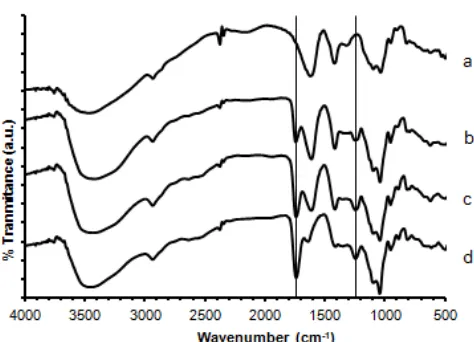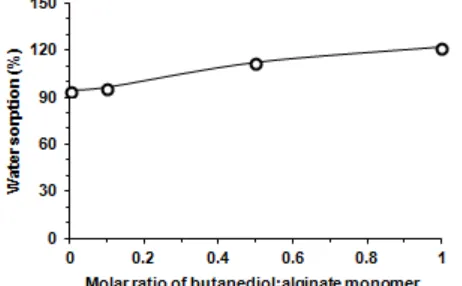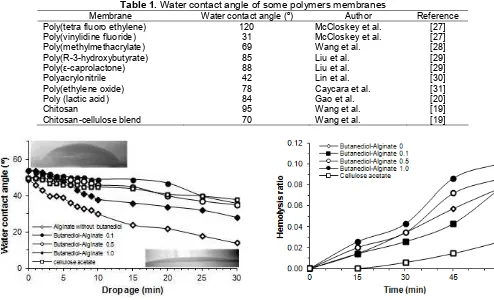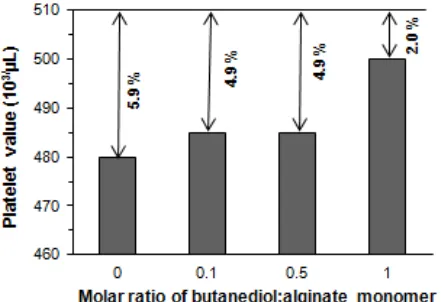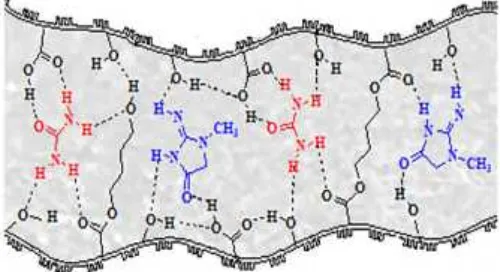CHARACTERIZATION OF BUTANEDIOL-ALGINATE ESTER
AS CANDIDATE OF HEMODIALYSIS MEMBRANE
Choirul Amri
1,2,*, Mudasir
2, Dwi Siswanta
2, and Roto Roto
2 1Department of Environmental Health, Poltekkes Kermenkes Yogyakarta, Jl. Tatabumi No. 3 Banyuraden, Yogyakarta 55293 2
Department of Chemistry, Faculty of Mathematics and Natural Sciences, Universitas Gadjah Mada, Sekip Utara PO BOX BLS 21 Yogyakarta 55281, Indonesia
Received October 23, 2014; Accepted April 16, 2015
ABSTRACT
An ester of butanediol-alginate has been studied as a possible hemodialysis membrane. With 1,4-butanediol molar ratio of 0.1, 0.5, and 1.0, it showed that the membrane mechanical properties, stability, protein adsorption, platelet adhesion and performance for urea and creatinine clearance are better than that of unmodified alginate. The increase in 1,4-butanediol molar ratio causes hemodialysis ratio to improve, and causes protein adsorption and platelet adhesion at the membrane surface to decrease. In the case of protein adsorption and platelet adhesion, the membrane with the molar ratio of 1.0 has better hemocompatibility properties. In the hemodialysis test for 4 h, using 2.742 mg cm-2h-1of urea and 0.058 mg cm-2h-1of creatinine flux, this membrane showed that 48.5% of urea and 44.2% of creatinine were cleaned.
Keywords:butanediol-alginate ester; hemodialysis membrane; hemocompatibility
ABSTRAK
Ester butanadiol-alginat telah dipelajari mengenai kemungkinannya sebagai membran hemodialisis. Pada rasio mol 1,4-butanadiol:monomer alginat 0,1; 0,5; dan 1,0 menunjukkan bahwa kekuatan mekanik, stabilitas, adsorpsi protein, pelekatan trombosit dan kinerja klirens urea dan kreatinin membran lebih baik daripada alginat tanpa modifikasi. Peningkatan rasio mol 1,4-butanadiol menyebabkan peningkatan rasio hemolisis dan penurunan adsorpsi protein dan pelekatan trombosit pada permukaan membran. Membran dengan rasio mol 1,0 menunjukkan adsorpsi protein dan pelekatan trombosit yang rendah sebagai indikasi hemokompatibilitas yang lebih baik. Pada uji simulasi dialisis selama 4 jam, membran ini mampu mengurangi konsentrasi urea 48,5% dan kreatinin 33,2%, dengan fluks urea dan kreatinin masing-masing 2,74 dan 0,058 mg cm-2jam-1.
Kata Kunci:Ester butanadiol-alginat; membran hemodialisis; hemokompatibilitas
INTRODUCTION
Hemodialysis is an important clinical procedure for dialysis of blood. It is commonly used for therapy of patients with end-stage renal disease that others therapy cannot be administered [1]. Special component in the process of hemodialysis is a semipermeable membrane that will allow the passage of low molecular weight of solutes of toxic uremic (i.e. urea and creatinine), while protein molecules remain to stay in the blood [2-3]. Cellulose and its derivatives, naturally based polymers, are often used as membrane in hemodialysis [4].
One of natural polymers with structure similar to cellulose is alginate. Alginate is a polysaccharide
containing β-D-mannuronic and α-L-guluronic which
attributed to 1-4 bond that can be obtained from marine brown algae, such asSargassum SpandPhaeophyceae [5]. It is one of water soluble polysaccharides [6]. This
polymer is able to form insoluble gel in water as alginic acid and calcium alginate [7], can be made as a membrane [8-10], is grouped as substance with elastic impressing [11], contains carboxyl and hydroxyl groups in its structure which can be modified [12], is nontoxic and biodegradable [13]. Since its carboxylic (–COOH) and hydroxyl (–OH) groups are able to form hydrogen bond to urea and creatinine, it is expected to be a good candidate as hemodialysis membrane. This material is interesting to be studied as hemodialysis membrane due to the pore function mechanism and interaction with urea and creatinine.
The use of alginate as membrane has been reported earlier due to the fact that it has carboxylic and hydroxyl groups that can form intermolecular and intramolecular hydrogen bond. Unmodified alginate may have weak stability against water since it has mainly carboxylic groups. In this study, the carboxylic groups of alginate is modified by esterification using 1,4-butanediol. The resulting ester is expected to have balance performance between hydrophilicity and hydrophobicity. The membrane of butanediol-alginate ester may be used as a mass transfer channel that can transport toxic uremic compounds of urea and creatinine through hydrogen bond. The modification is also expected to reduce protein adsorption and platelet adhesion to the surface. The mechanical properties (tensile strength and elongation), water sorption and stability, hydrophilicity, hemocompatibility (hemolysis, protein adsorption, platelet adhesion), and dialysis performance to urea and creatinine clearance are tested. Cellulose acetate-based membrane is used as comparison.
EXPERIMENTAL SECTION
Materials
Sodium alginate (the viscosity of 2% aqueous solution at 25 °C is 250 cps) from Sigma-Aldrich. Picric acid, urea, creatinine, 1,4-butanediol, sodium hydroxide, hydrochloric acid, sodium chloride, disodium hydrogen phosphate, potassium dihydrogen phosphate, diammonium oxalate, potassium sodium tartrate tetrahydrate, Copper(II) sulfate, and potassium iodide from Merck. Fluitest urea from Bavaria Diagnostica Germany for urea analysis.
Instrumentation
FTIR Spectrometer (Shimadzu), UV-Vis Spectrophotometer (Thermo Genessys 10 uv scanning), Hemocytometer (Neubauer). Universal testing machine for mechanical test. Digital camera microscope (Nicon).
Procedure
Preparation and characterization of butanediol-alginate ester membranes
The membrane was prepared from the product of esterification of alginate with 1,4-butanediol. A portion of 10 mL of 2% (w/v) sodium alginate (Sigma, the viscosity of 2% aqueous solution at 25 °C is 250 cps) and 1,4-butanediol (Merck) with predetermined weight (0, 15.8, 79.1, and 158.2 are poured in a petri dish Ø 6 cm, to make a mixture with 1,4-butanediol-monomer to alginate molar ratio of 0, 0.1, 0.5, and 1.0. The mixture was
stirred with magnetic stirrer for 30 min and was allowed to cool in a refrigerator at 4 °C for 24 h to eliminate air bubble. Alginate mixture was dried at 80 °C for 8 h and 10 mL HCl 1M was added. The mixture was incubated at 40 °C for 1 h. The membrane was washed with distilled water and dried 40 °C for 24 h. FTIR spectra was obtained on a Shimadzu FTIR spectrometer in wavenumber range of 4000-400 cm-1.
Mechanical properties of the membrane
For mechanical properties test, the membrane is cut into 2 x 11 cm. The mechanical properties of the membrane is tested using a universal testing machine. The stress applied is in the MPa unit while the speed is in mm/min.
Water sorption and stability
The water sorption of the esterification product was determined by swelling the membranes in phosphate-buffered saline (PBS) pH 7.4. A known weight of dried membrane was immersed in the media at room temperature for 4 hours. The percentage of membrane water sorption (WS) was calculated using the following Eq. 1 [14].
wet dry
The weight of the membrane after wáter sorption (Wwet) and the weight after drying at 40 °C for 24 h and
allowing to cool down in a desiccator for 1 h (Wpost)
were recorded. Stability of membrane (SM) was calculated using following Eq. 2.
dry postHydrophilicity of the membrane was measured using water contact angle method [15]. The membrane with flat surface was placed on a glass slide. A drop of water (10 µL) was dropped on the top of the membrane from 1 cm apart. The contact angle was immediately recorded after the water was dropped, and recorded every minute for the first 10 min, after 15 min, and after 20 min. Based on picture, the contact angle of the water-membrane surface was determined.
Hemocompatibility study of the membrane
(PPP) was obtained by centrifugation WB at 3000 rpm for 15 min.
For hemolysis ratio test, a 1 x 1 cm2 of membrane was prepared and washed three times with doublé distilled water and 0.9% sodium chloride (NaCl) solution. The membrane was soaked in 0.9% NaCl solution at 37 °C for 30 min, then soaked in the WB mixture (5 mL 0.9% NaCl and 20 µL WB) at 37 °C for 15 min. The soaking time was varied for 30, 45, and 60 min. Then the WB mixtures were centrifuged at 1500 rpm for 10 min. The absorbance of the solution was determined at 546 nm. The hemolysis ratio (HR) was calculated using Eq. 3 [18].
PS NN
A - A HR =
A - A (3)
Where AS is the absorbance of samples, AN is the
absorbance of negative reference, and AP is the
absorbance value of positive reference.
For protein adsorption test, the membrane with an area of 2 x 2 cm2 was immersed in 1 mL PPP and incubated at 37 °C for 1 h, then it was subsequently rinsed slightly with PBS solution and double distilled water. The membrane was washed with 2% sodium dodecyl sulfate (SDS) to remove the adsorbed protein. The protein concentration in the washing solution was determined by using the biuret spectrophotometric method.
For the platelet adhesion test, a 2 x 2 cm2 of the membrane was prepared. After washing with PBS buffer solution (pH 7.4) then the membrane was immersed in 1 mL PRP at 37 °C for 1 h. Platelet counts before and after immersion were determined using hemocytometer (Neubauer, Germany). The membrane was rinsed three times using PBS to remove unstable platelet. Then, 2.5%wt of glutaraldehyde was added into the solution for one night to fix the adsorbed platelets. The samples were dehydrated stepwise using 25%, 50%, 75%, 100% (v/v) ethanol/water solution for 10 min in sequence. Platelet adhesion on the butanediol-alginate membrane was observed by SEM after freeze drying.
Dialysis simulation
The membrane was attached at the dialysis apparatus between two compartments with the effective diffusion area 3.14 cm2. The source compartment was filled with 30 mL of solution containing urea 200 mg/dL and creatinine 5 mg/dL, while at dialysate compartment was filled with 30 mL PBS (pH 7.4). The concentration of urea (phenol blue enzymatic method) and creatinine (picric alkali method) at the solutions at each compartment (source and dialysate) were determined at 0, 1, 2, 3, and 4 h. Clearance of urea and creatinine during 1, 2, 3, and 4 h was calculated using Eq. 4 [16].
0 t0 C -C
SC % = x 100
C
(4)
Where SC is solute clearance, C0and Ctare the solute
concentrations in the testing solution reservoir at time t=0 and t=1, 2, 3, 4 h, respectively. The flux of urea and creatinine were determined using Eq. 5 [17].
J = W At (5)
Fig 1. FTIR spectra of butanediol-alginate ester membranes prepared without 1,4-butanediol (a), with butanediol-alginate in molar ratio of 0.1 (b), 0.5 (c), and 1.0 (d)
Fig 3. Tensile strength of dry butanediol-alginate membranes (a) and wet (b)
Fig 4. Elongation of dry butanediol-alginate membranes (a) and wet (b)
Fig 5. Water sorption of butanediol-alginate ester
membrane Fig 6.Stability of butanediol-alginate ester membrane
J is a flux of solute (mg cm-2h-1), W is the mass of solute diffused (mg), A is diffusion area (cm2), and t is diffusion time (hour).
RESULT AND DISCUSSION
Characterization of Membrane Surface
FTIR spectra of ester butanediol-alginate membranes is shown in Fig. 1. The peaks with different intensity due to C=O stretching are appeared at 1735 cm-1for membrane prepared with molar ratio of 0.1, 0.5, and 1.0. The peak at 1620 cm-1is attributed to C=O stretching of remaining carboxylic group of alginate. The peak at 1250 cm-1 is assigned to C–O stretching of the ester. The peak at 3433 cm-1is attributed to the –OH groups. The peak at 1620 cm-1is due to –COOH left in alginate, and the peak at 1735 cm-1is assigned for C=O of the ester. Fig. 2 shows SEM micrograph of the membrane before and after use. The membrane is transparent with no regular pore size less.
Mechanical Properties of Membrane
The results of tensile strength measurement is shown in Fig. 3, while elongation is given in Fig. 4. The tensile strengths of the ester with molar ratio of 0, 0.1, 0.5, and 1.0 when dry are 19.5, 36.4, 35.0, and 32.3 MPa, respectively. Its elongations are 3.8, 4.5, 4.9, and 6.0%, respectively. It is clearly shown that the esterification results in the tensile strength and elongation of the membrane to increase. At the butanediol to alginate molar ratio of 0.1, the tensile strength reaches 36.4 MPa.
Table 1.Water contact angle of some polymers membranes
Membrane Water contact angle (º) Author Reference
Poly(tetra fluoro ethylene)
Fig 7. Water contact angle of butanediol-alginate ester membranes with reference of cellulose acetate membrane at various drop time
Fig 8. Hemolysis performance of butanediol-alginate ester membrane with reference of cellulose acetate membrane as function of time
The mechanical strength of membranes in wet condition is important for biomaterial application both in vitro and in vivo [19]. The mechanical strength of butanediol-alginate ester membranes with molar ratio of 0, 0.1, 0.5, and 1.0 in wet state (after diffusion use for 4 h) decreases by 90.2, 89.8, 87.6, and 82.8%, respectively. Meanwhile, its elongation increases, probably due to water plasticization on the membrane.
Stability and Water Sorption
The stability of the membrane is higher than that of 1,4-butanediol (Fig. 6). The membrane with molar ratio of 0.1 has 99% of stability, while at molar ratio of 0.5 and 1.0 it has similar stability to that of cellulose acetate, i.e. 100%. Unmodified alginate membrane is easier to become wet. Esterification leads to shift the membrane from less hydrophobic to more hydrophobic (Fig. 7). This can increase membrane stability in water. The variability of the water sorption properties of the membrane (Fig. 5) based on the variation of the molar ratio of 1,4-butanediol in the membrane may be explained with respect to the rationale of the porosity of the membrane. By grafting and crosslinking of the alginate using 1,4-butanediol, more empty space will be formed in the
membrane, so that the membrane can trap more water molecules in its pore cavities.
Hydrophilicity of Membranes
The balance of hydrophilic and hydrophobic properties of a material which contact to the human blood represents an important factor [20] to give a better biocompatibility by decreasing adsorption of protein on the membrane surface [2]. The relative hydrophilic-hydrophobic properties of the membrane surface can be evaluated by measurement of the contact angle of the water drop on the membrane surface. Low water contact angle normally represents a high hydrophilicity of membrane surface [21]. The water contact angle of butanediol-alginate ester membrane is shown in Fig. 7. As comparison, water contact angle of some other membranes is also presented in Table 1.
Fig 9.Plasma protein adsorption on butanediol-alginate ester membrane
Fig 10.Decrease in percentage of platelet in PRP after contacting with the butanediol-alginate ester membrane for 1 h. The initial amount platelet in PRP 510000 cells/µL
Fig 11.SEM micrograph of adhesion platelet type on the membrane surface of butanediol-alginate ester
of the membrane. Therefore, by varying the molar ratio of the butanediol to alginate monomer, it is expected that hydrophilicity-hydrophobicity balance of the membranes can be adjusted.
Hemocompatibility of Membranes
In this study, the membrane hemocompatibility was examined by conducting hemolysis test, protein adsorption, and platelet adhesion. Hemolysis of blood is a serious problem related to the material biocompatibility [22]. Test of hemolysis in vitro has frequently used as a simple and reliable test for the assessment of blood compatibility of a material [23].
The hemolysis ratio of the membranes is presented in Fig. 8. Hemolysis ratio of the membrane with molar ratio of 0.1 shows a little decrease, but after 45-60 min the hemolysis ratio of membrane is found to increase
closer to that of the alginate membrane without butanediol. The membrane with molar ratio of 0.5 and 1.0 exhibits hemolysis ratio higher than that without 1,4-butanediol. It seems that esterification of the carboxylic groups affecting the biocompability of the membrane. In general, the membrane based on butanediol-alginate ester shows greater hemolysis ratio than that of the cellulose acetate-based membrane.
Fig. 9 shows the amount of protein plasma adsorption on the membrane surface. The membrane prepared with molar ratio of 0.5 is able to decrease the adsorption of protein plasma on the membrane surface by as much as 10.4% (from 4.8 mg/cm2to 4.5 mg/cm2) compared to membrane without butanediol, while at ratio of 1.0, it decreases by 16.7% (from 4.8 mg/cm2to 4.0 mg/cm2). With molar ratio of 0.1, the decrease in protein adsorption on the membrane surface was not observed. The adsorption of the protein plasma on the membrane surface is strongly affected by the characteristics of the membrane surface, such as hydrophilicity, crudity, and its chemical properties [24]. In general, the membrane based on ester alginate showed a low hydrophilicity properties (or higher hydrophobicity), so that the decrease in hydrophilicity properties may contribute to the decrease in the adsorption of protein plasma.
The decrease of plasma protein adsorption may also relate to the existence of 4-carbon-chain of 1,4-butanediol [25-26] and the esterification of the carboxylic groups. Unesterified carboxylic groups has tendency to interact with the protein through carboxylic (–COOH) groups of the alginate and amine groups (–NH2) of the protein. Increasing the butanediol to
Fig 12.Performance of urea (a) and creatinine (b) clearance of butanediol-alginate ester membranes with the molar ratio of 0, 0.1, 0.5, and 1.0 in a dialysis simulation experiment for 1, 2, 3, and 4 h
Table 2. Urea and creatinine flux through butanediol-alginate ester membranes
Flux (mg cm-2h-1) Molar ratio of
butanediol-alginate Urea Creatinine
0 2.54 0.059
0.1 2.61 0.058
0.5 2.75 0.061
1.0 2.74 0.058
Fig. 10 depicts the number of platelet heldon membrane surface for the area of 2 x 2 cm2. The initial platelet count in PRP was 510000/µL. After contacting with the butanediol-alginate ester membrane with molar ratio of 0 (without 1,4-butanediol), molar ratio of 0.1, 0.5,and 1.0, the platelet counts become 480000/µL (-5.9%), 485000/µL (-4.9%), 485000/µL (-4.9%), and 500000/µL (-2.0%), respectively. Meanwhile, for the cellulose acetate membrane, the decrease of platelet count was only 1.0% (from 510000/µL to 505000/µL). The adhesion of platelet on the membrane surface was proportional to the platelet decrease in the PRP. In general, adhesion of platelet on modified alginate membrane was lower than that of unmodified. The lowest platelet adhesion was observed for the membrane with molar ratio of 1.0.
Platelet adhesion on membrane is closely related to the protein adsorption [23]. It seems that decrease in protein adsorption on the membrane surface (Fig. 9) showed the same tendency for the platelet adhesion (Fig. 10). Fig. 11 shows the result of SEM imaging of the type of platelet adhesion on the membrane of butanediol-alginate ester. Platelet adhesion on the membrane surface occurs simultaneously with the adsorption of plasma protein, as observed that the platelets are pre-packed by the material of protein plasma (especially fibrinogen) on the membrane surface. Therefore, it is difficult to conduct direct assessment of platelet adhesion on the membrane. Most of works have
been applying the indirect assessment of the amount of platelet in PRP.
Dialysis Performance
In this study, the performances of the modified membrane have also been examined by measuring the clearance efficiency of urea and creatinine. Urea and creatinine clearance by the membranes are presented in Fig. 12. In the dialysis test for 4 hours using membrane with effective surface area of 3.14 cm2, the membrane modified with molar ratio of 0, 0.1, 0.5, and 1.0 reduces the urea of 45.3%, 47.7%, 50.0%, and 48.5% (from 200 mg/dL of initial urea concentration), respectively, while cellulose acetate membrane reduces urea by 17.2%. Meanwhile, for creatinine, the decrease is 42.4, 43,5, 45.4, and 44.2% (from 5 mg/dL of initial creatinine concentration), respectively, while for cellulose acetate the decrease is 10.8%. Urea fluxes are 2.54, 2.61, 2.75, and 2.74 mg cm-2 h-1, respectively, and that for cellulose acetate is 0.90 mg cm-2h-1. Meanwhile, the creatinine fluxes are 0.059, 0.058, 0.061, and 0.058 mg cm-2h-1 (Table 2), while that for cellulose acetate is 0.015 mg cm-2h-1. It has been demonstrated that these membranes give a better performance of clearance efficiency of urea and creatinine than that shown by the cellulose acetate.
Fig 13. Proposed interaction of urea-creatinine with the butanediol-alginate ester membrane through hydrogen bond
ratio of 1.0, an extensive crosslinking reaction resulted in the decrease of water sorption and porosity, so that the urea and creatinine clearance also tend to decrease.
Based on the FTIR spectra, membrane with molar ratio 0.1, 0.5, and 1 shows a partial esterification (not all groups of carboxylic acid are esterified) as indicated by the presence of –OH, –COOH, and C=O ester functional groups. These functional groups facilitate the formation of hydrogen bonds with urea and creatinine. The functional groups in the membrane cavity surface may facilitate the active transport of urea and creatinine through the membrane. Therefore, it is believed that the functional group forms an active channel for the transport of urea and creatinine. H atoms of –NH2groups
of urea compound and =NH of creatinine compound can interact with the O atom of –OH, –COOH, or C=O ester groups of butanediol-alginate membrane. Hydrogen bond may also form through the interaction of the O atom of C=O of urea and creatinine with the H atom of –OH and –COOH groups of butanediol-alginate membrane. Fig. 13 shows the possibilities of interaction between urea-creatinine with the butanediol-alginate ester membrane through hydrogen bond. Hydrogen bonds formed are weak intermolecular hydrogen bonds, so that this hydrogen bond will be ruptured when urea and creatinine are in contact with the dialysate in the reverse membrane surface. This process takes place continuously until the urea and creatinine concentration in source and receiver dialysate reaches equilibrium.
CONCLUSION
The membrane prepared from butanediol-alginate ester has mechanical strength, stability, protein adsorption, platelet adhesion, urea and creatinine diffusion, and hydrophobicity better than that of unmodified alginate. The butanediol to alginate molar ratio of 0.1 produces the highest tensile strength of 36.4 MPa. Increase in molar ratio causes elongation to
increase. At molar ratio of 1.0, the membrane has 6% elongation when dry and 36.0% when wet. The stability of membrane can reach 100% at molar ratio of 0.5 and 1.0. Increase in molar ratio results in the increase of hemolysis ratio, and causes the adsorption of protein and platelet adhesion on the membrane surface to decrease. In the case of protein adsorption and platelet adhesion, the membrane with molar ratio of 1.0 has better hemocompatibility behavior. In the dialysis simulation done for 4 h with the urea flux 2.74 mg cm-2h-1and creatinine flux 0.058 mg cm-2h-1, the membrane can reduce 48.5% and 44.2% of urea and creatinine concentration, respectively.
REFERENCES
1. Li, L., Cheng, C., Xiang, T., Tang, M., Zhao, W., Sun, S., and Zhao, C., 2012, J. Membr. Sci., 405-406, 261–274.
2. Daugirdas, J.T., Blake, P.G., and Ing, T.S., 2007, Handbook of Dialysis, 4thed., Lippincott Williams & Wilkins, Philadelphia, USA.
3. Levy, J., Morgan, J., and Brown, E., 2004, Oxford Handbook of Dialysis, 2nd ed., Oxford University Press, London, UK.
4. Stamatialis, D.F., Papenburg, B.J., Gironés, M., Saiful, S., Bettahalli, S.N.M., Schmitmeier, S., and Wessling, M., 2008, J. Membr. Sci., 308(1-2), 1–34.
5. Kreer, M., Swami, K., Kumar, R., Kanwar, K., Kaur, P., Singh, P., and Kaur, A., 2010,J. Chem. Pharm. Res., 2(4), 851–860.
6. Pereira, R., Tojeira, A., Vaz, D.C., Mendes, A., and Bártolo, P., 2011, Int. J. Polym. Anal. Charact., 16(7), 449–464.
7. Davidovich-Pinhas, M., and Bianco-Peled, H., 2010,Carbohydr. Polym., 79(4), 1020–1027. 8. Bhat, S.D., Naidu, B.V.K., Shanbhag, G.V.
Halligudi, S.B., Sairam, M., and Aminabhavi, T.M., 2006,Sep. Purif. Technol., 49, 56–63.
9. Kaban, J., Bangun, H., Sawolo, A.K., and Daniel, 2006,Jurnal Sains Kimia,10(1), 10–16.
10. Kalyani, S., Smitha, B., Sridhar, S., and Krshnaiah, A., 2008,Desalination, 229(1-3), 68–81.
11. Saniour, S.H.S., Abd El-Ghaffar, M.A., Fath El-Bab, I.I., and Saba, S.A., 2011, J. Am. Sci., 7(9), 443–448.
12. Zhang, S., and Luo, J., 2011,J. Eng. Fibers Fabr., 6(3), 69-72.
13. Patil, P., Chanvanke, D., and Wagh, M., 2012,Int. J. Pharm.Pharm. Sci., 4(S4), 27–32.
14. Nasir, N.F.M., Zain, N.M., Raha, M.G., and Kadri, N.A., 2005,Am. J. Appl. Sci., 2(12), 1578–1583. 15. Lamour, G., Hamraoui, A., Buvailo, A., Xing, Y.,
and Borguet, E., 2010, J. Chem. Educ., 87(12), 1403–1407.
16. Idris, A., Yee, H.K., and Kee, C.M., 2009, Jurnal Teknologi, 51(F), 67–76.
17. Lokesh, B.G., Krishna Rao, K.S.V, Reddy, K.M., Chodoji Rao, K., and Srinivasa Rao, P., 2008, Desalination, 233(1-3), 166–172.
18. Xu, R., Manias, E., Snyder, A.J., and Runt, J., 2001, Macromolecules, 34(2), 337–339.
19. Wang, X., Chang, P.R., Li, Z., Wang, H., Liang, H., Cao, X., and Chen., Y., 2011, BioResources, 6(2), 1392–1413
20. Gao, A., Liu, F., and Xue, L., 2014, J. Membr. Sci., 452, 390–399.
21. Haitao, W., Liu, Y., Xuehui, Z., and Qiyun, D., 2009, Chin. J. Chem. Eng., 17(2), 324–329.
22. Wen, X.W., Pei, S.P., Li, H., Ai, F., Chen, H., Li, K.Y., Wang, Q., and Zhang, Y.M., 2010, J. Mater. Sci., 45(10), 2788–2797.
23. Zhang, W.F., Zhou, H.Y., Chen, X.G., Tang, S.H., and Zhang, J.J., 2009, J. Mater. Sci. - Mater. Med., 20(6), 1321–1330.
24. Lin, W-C., Liu, T-Y., and Yang, M-C., 2004, Biomaterials,25(10), 1947–1957.
25. D’Ayala, G.G., Malinconico, M., and Laurienzo, P., 2008,Molecules,13(9), 2069–2106.
26. Kang, H-A., Shin, M.S., and Yang, J-W., 2002, Polym. Bull., 47(5), 429–435.
27. McCloskey, B.D., Park, H.B., Ju, H., Rowe, B.W., Miller, D.J., and Freeman, B.D., 2012, J. Membr. Sci., 413-414, 82–90.
28. Wang, X., Yang, N., Xu, Q., Mao, C., Hou, X., and Shen, J., 2012,e-Polymers,081, 1–8.
29. Liu, Q., Cheng, S., Li, Z., Xu, K., and Chen, G.Q., 2008, J. Biomed. Mater. Res. Part A, 90A(4), 1162–1176.
30. Lin, W-C., Liu, T-Y., and Yang, M-C., 2004, Biomaterials, 25(10), 1947–1957.
31. Çaykara, T., Demirci, S., Mehmet S. Eroğlu, M.S.,
and Gȕven, O., 2005, Polymer, 46(24),
